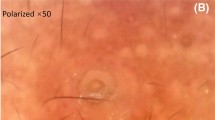Summary
A total of 375 anaerobic and microaerophilic coryneform rods, isolated from the pilosebaceous ducts of 26 healthy persons (71 strains) and from comedones (93 strains), pustules (107 strains), and the unaffected skin (104 strains) of 36 acne patients were classified according to the species key in Bergey's manual, the biotyping scheme of Pulverer and Ko, the serotyping schedule of Höffler et al., and the phage typing schedule of Jong et al. The statistical evaluation demonstrated certain differences in the frequencies of the Propionibacterium species and types between the different groups tested. Thus, the species P. granulosum was isolated only from acne patients (50.0% of patients examined) and was found more frequently in comedones and pustules than in unaffected follicles in acne patients. The majority of P. granulosum strains belonged to serotype II (95). Biotype A propionibacteria were more feequently found in strains from healthy controls (52.1% of strains) than in strains from comedones (17.2%), pustules (27.1%) and unaffected skin (38.5%) of the acne patients. The results of phagetyping showed that the P. acnes lysotype I was more frequent in acne patients (total: 73.2% of strains), especially in the inflamed pustules (88.5%), than in healthy controls (55.1%).
Similar content being viewed by others
References
Fanta D (1978) Akne. Klinische und experimentellc Grundlagen zur Hormontherapie. Springer, Vienna New York
Gloor M, Franke M (1978) On the propionibacteria in the pilosebaceous ducts of uninvolved skin of acne-patients. Arch Dermatol Res 262:125–129
Gloor M, Horáček (1979) Über die Hautoberflächenlipide. In: Handbuch der Haut- und Geschlechtskrankheiten, Ergänzungswerk, vol 1, part A. Springer, Berlin Heidelberg New York, S 263–348
Gloor M, Lamerz A, Höffler U, Franke M (1980) Über die Propionibakterien im Talgdrüseninfundibulum der nichterkrankten Haut bei Acne vulgaris. Untersuchungen an jugendlichen Aknepatienten mit ausgeprägter Komedonenbildung und gesunden Vergleichspersonen. Dermatol Monatsschr 166:798–803
Hoeffler U (1977) Enzymatic and hemolytic properties of Propionibacterium acnes and related bacteria. J Clin Microbiol 6:555–558
Höffler U, Goor M, Peters G, Ko HL, Bräutigam A, Thurn A, Pulverer G (1980) Qualitative and quantitative investigations on the resident bacterial skin flora in healthy persons and in the nonaffected skin of patients with seborrheic eczema. Arch Dermatol Res 268:297–312
Höffler U, Ko HL, Pulverer G (1977) Serotyping of Propionibacterium acnes and related microbial species. FEMS Microbiol Lett 2:5–9
Holdeman LV, Cato EP, Moore WEC (1977) Anaerobe Laboratory Manual, 4th edn. Anaerobe Laboratory, Virginia Polytechnic Institute and State University Blacksburg, Virginia
Holland KT, Roberts CD, Cunliffe WJ, Williams M (1974) A technique for sampling microorganisms from the pilosebaceous ducts. J Appl Bacteriol 37:289–296
Jong EC, Ko HL, Pulverer G (1975) Studies on bacteriophages of Propionibacterium acnes. Med Microbiol Immunol (Berl) 161:263–271
Knop J (1980) Spielen immunologische Gesichtspunkte in der Akne-Pathogenese eine Rolle? Fette, Seifen, Anstrichmitel 82:514–518
Lamerz A (1980) Über die Propionibakterien im Talgdrüseninfundibulum der nichterkrankten Haut bei Acne vulgaris und über die Bedeutung der Micrococcaceae bei der Pathogenese der Acne vulgaris. Dissertation, University of Heidelberg
Lentze I, Ko HL, Höffler U (1979) Differenzierung unterschiedlicher Propionibakterien-Spezies aus Akne vulgaris-Effloreszenzen. Hautarzt 30:242–247
Leyden JJ, McGinley KJ, Mills OH, Kligman AM (1975) Agerelated changes in the resident bacterial flora of the human face. J Invest Dermatol 65:379–381
Leyden JJ, McGinley KJ, Mills OH, Kligman AM (1975) Propionibacterium levels in patients with and without acne vulgaris. J Invest Dermatol 65:382–384
Marples RR, McGinley KJ, Mills OH (1973) Microbiology of comedones in acne vulgaris. J Invest Dermatol 60:80–83
McGinley KJ, Webster GF, Leyden JJ (1978) Regional variations of cutaneous Propionibacteria. Appl Euviron Microbiol 35:62–66
McGinley KJ, Webster GF, Ruggieri MR, Leyden JJ (1980) Regional variations in density of cutaneous Propionibacteria. Correlation of Propionibacterium acnes populations with sebaceous secretion. J Clin Microbiol 12:672–675
Moore WE, Holdeman LV (1974) Propionibacterium. In: Buchanan RE, Gibbons NE (eds) Bergey's manual of determinative bacteriology, 8th ed., Williams and Wilkins, Baltimore, pp 633–641
Plewig G, Kligman AM (1975) Acne. Morphogenesis and treatment. Springer, Berlin Heidelberg New York
Puhvel SM, Sakamoto M (1980) Cytotaxin production by comedonal bacteria (P. acnes, P. granulosum, S. epidermidis). J Invest Dermatol 74:36–39
Pulverer G, Ko HL (1973) Fermentative and serological studies on Propionibacterium acnes. Appl Microbiol 25:222–229
Syed SA (1976) A new medium for the detection of gelatine-hydrolizing activity of human dental plaque flora. J Clin Microbiol 3:200–202
Whiteside JA, Voss JG (1973) Incidence of lipolytic activity of Propionibacterium acnes (Corynebacterium acnes group I) and P. granulosum (C. acnes group II) in acne and in normal skin. J Invest Dermatol 60:94–97
Author information
Authors and Affiliations
Additional information
Dedicated to Professor Dr. Dr. h.c. U. W. Schnyder on the occasion of his 60th birthday
Supported by research grants of the Deutsche Forschungsgemeinschaft
Rights and permissions
About this article
Cite this article
Gehse, M., Höffer, U., Gloor, M. et al. Propionibacteria in patients with acne vulgaris and in healthy persons. Arch Dermatol Res 275, 100–104 (1983). https://doi.org/10.1007/BF00412883
Received:
Issue Date:
DOI: https://doi.org/10.1007/BF00412883



